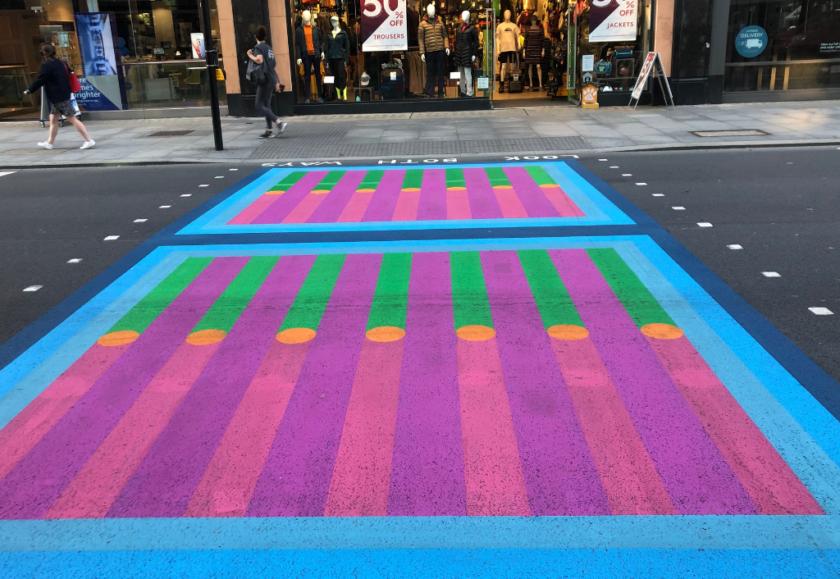Across the UK we are seeing more and more examples of ‘colourful crossings’, where the pedestrian crossing on the road is painted over with brightly coloured, often abstract, artistic designs. We have significant concerns about the safety and accessibility of these schemes.
We, together with 7 other disability organisations, have written an open letter to the Mayor of London setting out our objections to the engagement process for these schemes.
Open letter to the Mayor of London
Tuesday 28th September 2021
Dear Mayor Sadiq Khan,
Safety and accessibility of the Asphalt Art Project
We are a group of organisations representing many of the millions of disabled people who live in and visit London. We are writing to set out our significant concerns regarding the safety and accessibility of the ‘Asphalt Art Project’ (the installation of colourful patterns on road crossings) and our objections to the engagement process for these schemes.
Crossing the road safely is an essential part of negotiating our built environment and accessing our local community. The provision of safe crossing points affects everyone’s ability and desire to use their local streets, and this is especially crucial in enabling disabled people to make journeys as a pedestrian.
The past 18 months have seen a great number of changes made to the streetspace. As London adapted to the pandemic, the streets were transformed; with widened pavements, traffic calming measures, additional space for cycling, and more. Many of these changes were rolled out at pace, and implemented without due engagement with disabled people, and in many instances failed to identify negative impacts and mitigate against them. This has been thoroughly discussed and reflected upon (1), and in March this year TfL issued an updated version of their guidance (2) for Boroughs on Streetspace which stressed the importance of engaging with disabled people.
Given the many examples and opportunities for learning, it is disappointing to see another scheme repeating these patterns. The Asphalt Art Project demonstrates exactly what happens when meaningful engagement does not take place: it sadly results in schemes that are neither accessible nor inclusive.
In the accompanying pages to this letter, we have set out the impact these schemes will have on disabled people, the contradiction between these schemes and the welcome safety commitments made in Vision Zero, and our concerns regarding the engagement and Equality Impact Assessment processes for these crossings. We hope that your reply will address these issues, and will clarify whether London truly is open to everyone – including disabled Londoners and visitors.
Yours sincerely,
- Transport for All
- Alzheimer’s Society
- RNIB
- Guide Dogs
- Scope
- Age UK London
- Inclusion London
- London TravelWatch
1. Impact on disabled pedestrians
These designs create safety and accessibility concerns for some disabled people with particular impairments, as has been helpfully outlined in this letter from the Access Association (3). (We recommend reading their letter for full details of impacts on various impairment groups, and have outlined the major concerns below).
- For blind and visually impaired people, the consistency and predictability of signage is fundamental to being able to navigate safely and independently. The majority of visually impaired people have some sight. Designs and colours used on pedestrian crossings which are not consistent with traditional designs could cause confusion and risk safety. The use of black and white in traditional pedestrian crossings offer high contrast which is essential for people with low vision to detect them and stay on course when crossing roads. We have also heard accounts from visually impaired people with light sensitivity who find the artwork painful to look at.
- People with learning disabilities are likely to find it difficult to interpret abstract artwork as a crossing. Again, the consistency and familiarity of road signage is critical to enabling members of this community to interpret crossings as a safe place to cross.
- People affected by dementia often experience perceptual problems called ‘misperceptions’ which happens when a person sees one thing as something else (4). Patterns on the floor can be confusing or misinterpreted: a wavy line might look like a moving snake, for example, a dark shape can look like a hole, or blue paint can look like water. Sudden changes in contrast can make the floor levels look uneven, like a step, and this can cause hesitation or unsteadiness which can lead to falls (5). It has long been established that best practice for making walkways safe is to avoid patterns.
- For many neurodivergent people with a sensory processing difference, including Autistic people, sensory overload and/or distress can be caused when encountering “visual noise” such as bright colours, patterns and stripes. This may lead to people avoiding the pattern and crossing the road elsewhere without a controlled crossing, or to needing more time to cross or stopping in the road in order to process the visual complexity.
2. Vision Zero and road safety
Disabled pedestrians are already often more ‘vulnerable’ to collisions while using crossings than our non-disabled counterparts. For example, research suggests (6) that people with mild dementia, compared to people without dementia, have an increased likelihood of collisions, and this was associated with impairments in process speed and visual attention abilities. Therefore, any factors that could influence visual attention may increase risk for people with mild dementia crossing the road.
We welcome the Mayor’s zero tolerance approach to road traffic accidents, and have greatly supported Vision Zero as set out in the Mayor’s Transport Strategy (7) aiming for the total elimination of all deaths and serious injuries from London’s transport network by 2041.
We feel that the Asphalt Art project does not fit with the strategies set out in Vision Zero, particularly the point on Safe Streets; “ensuring safety is at the forefront of all design schemes”. With such major safety concerns raised, we cannot see how this project has been approved and implemented.
3. Exclusion
Asphalt Art is the signature project for the Mayor’s Let’s Do London Autumn campaign, designed to draw Londoners and visitors back to the city and celebrate all the vibrancy and diversity our culture has to offer.
We are concerned that, given the safety and accessibility implications, many disabled people will avoid the crossings and so will be persuaded away from these spaces altogether. Avoiding public space can lead to individuals becoming cut off from their communities, and facing even greater loneliness and isolation. The proportion of disabled people who report feeling lonely “often or always” is nearly four times that of non-disabled people (8), and we fear this project will exacerbate an existing issue and heighten the exclusion disabled people already face. This raises questions on who this project is intended to attract, and who London is open for.
It is almost impossible to meaningfully capture data on the people who aren’t present in public space because they are staying inside and avoiding the area. This means that any attempts to rigorously monitor this project’s impact on disabled people will fall short: how can we know who is missing?
4. Decision making and engagement
We have significant concerns about the scope and scale of meaningful engagement that has been undertaken with disabled people, and the extent to which this engagement has impacted on the design and implementation of the schemes.
The Public Sector Equality Duty (PSED) is clear that any potential impacts on groups must be considered at an early stage of the formation of a new scheme and to inform whether or not it goes ahead, rather than being added on at the end of the process.
In communications about this project, we have seen the claim that ‘this is a unique activity on this scale and there is a lack of information on potential equality impacts and mitigations’ (9). Whilst ‘colourful crossings’ may be a relatively new concept, the impact of bold patterned flooring on disabled people has been well researched and understood. In 2018 there were British Standards explicitly recommending against contrasting patterns on pedestrian surfaces, describing them as “disorientating or misleading” (10). We are therefore concerned as to why this, and other existing, evidence and research has not been included in the EqIA for this project. The commitment from many areas who are implementing these schemes to conduct user testing with disabled people once the artwork is in place is misguided, and demonstrates a lack of understanding of the negative impact this will have on many groups of disabled people such as those we work with.
About our organisations
Transport for All is the only disabled-led group striving to increase access to transport and streetspace across the UK. We work with and for our members fighting for transport access, championing disabled people’s rights and providing an unrivalled community of support and advice.
Alzheimer’s Society is the UK’s leading dementia charity. We provide information and support, fund research, campaign to improve care and create lasting change for people affected by dementia in England, Wales and Northern Ireland.
RNIB is the UK’s leading sight loss charity and the largest community of blind and partially sighted people. Everyday 250 people begin to lose their sight. RNIB has a crucial role to play in creating a world where there are no barriers to people with sight loss. We want society, communities and individuals to see differently about sight loss.
Guide Dogs provides mobility services to increase the independence of people with sight loss in the UK. Alongside our mobility work, we campaign to break down physical and legal barriers to enable people with sight loss to live the life they choose.
Scope is a national pan-disability charity campaigning for the rights of Britain’s 14 million disabled people.
Age UK London campaigns for specific change to improve the lives of older Londoners and ensure that their experiences, needs and contributions are heard and taken into account by decision makers.
Inclusion London’s mission is to promote Deaf and Disabled people’s equality and inclusion by supporting Deaf and Disabled People’s Organisations (DDPOs) and campaigning for rights for Deaf and Disabled people across the UK.
London TravelWatch is the official watchdog organisation representing the interests of transport users in and around the capital.
References
(1) Mayor’s Question Time, ‘Pave The Way’ 18th March 2021 < https://www.london.gov.uk/questions/2021/0471>
(2) Transport For London, ‘Interim guidance for delivery using temporary and experimental schemes’ March 2021 < https://content.tfl.gov.uk/interim-guidance-for-delivery-using-temporary-and-experimental-schemes-march-2021.pdf>
(3) Access Association, ‘Colourful Pedestrian Crossings letter to Ministers’ 6th September 2021 < https://accessassociation.co.uk/2021/09/06/colourful-pedestrian-crossings-letter-to-ministers/>
(4) Ferman, T. J., Arvanitakis, Z., Fujishiro, H., Duara, R., Parfitt, F., Purdy, M., Waters, C., Barker, W., Graff-Radford, N. R., & Dickson, D. W. (2013). Pathology and temporal onset of visual hallucinations, misperceptions and family misidentification distinguishes dementia with Lewy bodies from Alzheimer’s disease. Parkinsonism & related disorders, 19(2), 227–231. https://doi.org/10.1016/j.parkreldis.2012.10.013
(5) Dommes, Aurélie & Wu, Ya-Huei & Aquino, Jean-Pierre & Pitti-Ferrandi, Hélène & Soleille, Martine & Martineau-Fleury, Sophie & Samson, Michel & Rigaud, Anne-Sophie. (2014). Is Mild Dementia Related to Unsafe Street-Crossing Decisions?. Alzheimer disease and associated disorders. 29. 10.1097/WAD.0000000000000074. < https://www.researchgate.net/publication/269466585_Is_Mild_Dementia_Related_to_Unsafe_Street-Crossing_Decisions>
(6) Dementia Services Development Centre, The importance of colour and contrast <https://dementia.stir.ac.uk/design/virtual-environments/importance-colour-and-contrast>
(7) Mayor’s Transport Strategy 2018 < https://www.london.gov.uk/what-we-do/transport/our-vision-transport/mayors-transport-strategy-2018?intcmp=46686>
(8) Office for National Statistics, ‘Disability, well-being and loneliness, UK: 2019’ < https://www.ons.gov.uk/peoplepopulationandcommunity/healthandsocialcare/disability/bulletins/disabilitywellbeingandlonelinessuk/2019>
(9) London Borough of Camden, Equality and Impact Assessment for Asphalt Art Installation for the London Design Festival <https://democracy.camden.gov.uk/documents/s98206/Appendix%20A%20-%20Equality%20Impact%20Assessment.pdf>
(10) BS 8300-1: 2018: “Although visual contrast is very useful in enabling partially sighted people to perceive boundaries, bold surface patterns can be disorientating or misleading, and should therefore be avoided. The use of colour, patterning, lettering and imagery on pedestrian surfaces can be particularly problematic for people who are blind or partially sighted and people who have sensory/neurological processing difficulties.”


